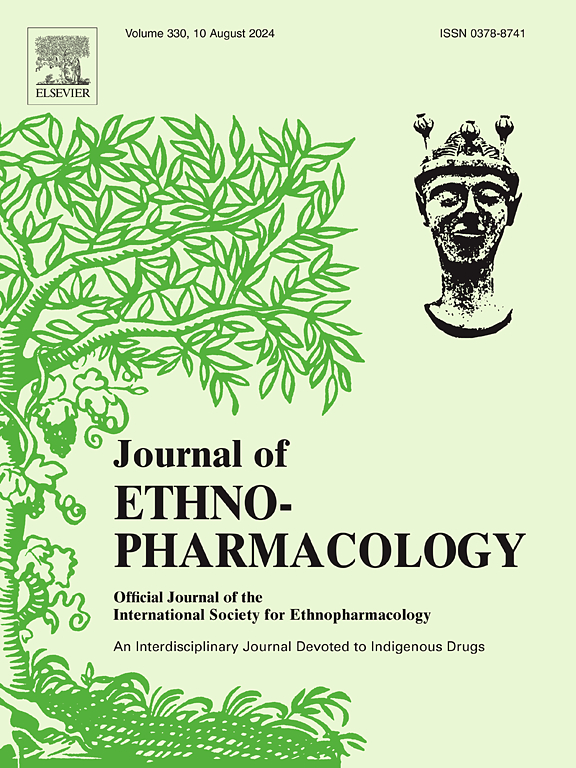Therapeutic effect and concomitant toxicity of hydrargyrum chloratum compositum on chronic difficult-to-heal wounds in rats
IF 4.8
2区 医学
Q1 CHEMISTRY, MEDICINAL
引用次数: 0
Abstract
Ethnopharmacological relevance
Hydrargyrum chloratum compositum(Hcc) is a traditional Chinese medicine for external use, with the efficacy of ‘transforming corrosion and pulling out toxins, removing corrosion and regenerating muscles’. The main components are mercuric chloride (HgCl2) and mercurous chloride (Hg2Cl2), which have antibacterial, corrosive and tissue repairing effects. However, the therapeutic mechanism and toxicity risk of its topical application for treating difficult-to-heal wounds have not been clearly explained.
Aims of the study
To investigate the therapeutic mechanism of Baishuidan on chronic non-healing wounds in rats and to assess the risk of mercury toxicity.
Methods
The antimicrobial activity of Hcc against Staphylococcus aureus, Candida albicans, Pseudomonas aeruginosa, and Streptococcus-β haemolyticus was assessed by the circle of inhibition assay, Minimum inhibitory concentration(MIC) and Minimum bactericidal concentration(MBC) assay and 24-h inhibition curve. SD rats were used to establish a chronic difficult-to-heal wound model. The efficacy of C. albicans and its effects on inflammatory and angiogenic factors were assessed by wound healing rate, histopathological analysis, immunohistochemical staining, and Elisa assay. The pathological effects of Hcc on the principal organs of rats and the accumulation of mercury ions were detected by hematoxylin-eosin (H&E) staining and atomic absorption spectrophotometry (AAS).
Results
Hcc showed different degrees of bacteriostatic effects on Staphylococcus aureus, Streptococcus-β haemolyticus, Pseudomonas aeruginosa, and Candida albicans. Among them, the most significant inhibitory effect was on S. aureus (MIC 4 μg/mL, MBC 8 μg/mL). Hcc significantly promoted the healing of skin wounds in rats, with the best effect in the middle-dose group. Pathological analysis showed that collagen fibre production and neocapillary formation increased and inflammatory cell infiltration decreased in the treatment group. Hcc improved the microenvironment of wounds by decreasing the level of the pro-inflammatory factor IL-6 and increasing the level of the anti-inflammatory factor IL-10. By activating the Pi3k - Akt and Notch1 - Vegfa signalling pathways, Hcc promotes cell proliferation and angiogenesis, accelerating wound healing. Hcc did not cause significant pathological damage to the major organs of rats at the therapeutic dose. However, a significant accumulation of mercury ions was detected in the kidneys, suggesting that long-term use may cause damage to renal function.
Conclusion
This study is the first to systematically investigate the multi-target, multi-pathway mechanism of action of Hydrargyrum Chloratum Compositum (Hcc) in treating chronic hard-to-heal wounds and to comprehensively assess its potential mercury toxicity risk. Through in vitro antimicrobial assays, animal models, histopathological analyses, protein expression and mercury ion accumulation assays, the present study revealed the unique mechanisms of Hcc in promoting wound healing, including inhibition of bacterial growth, modulation of immune-inflammatory responses, promotion of angiogenesis, and activation of key signalling pathways (Pi3k-Akt and Notch1-Vegfa pathways). In addition, this study is the first to evaluate the accumulation of mercury ions in Hcc in different organs, especially the significant accumulation in the kidney, which provides important safety data for clinical application. Compared with the existing literature, the present study verified the antimicrobial activity of Hcc, and revealed its specific mechanism in promoting wound healing, providing a scientific basis for the clinical use of Hcc.

求助全文
约1分钟内获得全文
求助全文
来源期刊

Journal of ethnopharmacology
医学-全科医学与补充医学
CiteScore
10.30
自引率
5.60%
发文量
967
审稿时长
77 days
期刊介绍:
The Journal of Ethnopharmacology is dedicated to the exchange of information and understandings about people''s use of plants, fungi, animals, microorganisms and minerals and their biological and pharmacological effects based on the principles established through international conventions. Early people confronted with illness and disease, discovered a wealth of useful therapeutic agents in the plant and animal kingdoms. The empirical knowledge of these medicinal substances and their toxic potential was passed on by oral tradition and sometimes recorded in herbals and other texts on materia medica. Many valuable drugs of today (e.g., atropine, ephedrine, tubocurarine, digoxin, reserpine) came into use through the study of indigenous remedies. Chemists continue to use plant-derived drugs (e.g., morphine, taxol, physostigmine, quinidine, emetine) as prototypes in their attempts to develop more effective and less toxic medicinals.
 求助内容:
求助内容: 应助结果提醒方式:
应助结果提醒方式:


